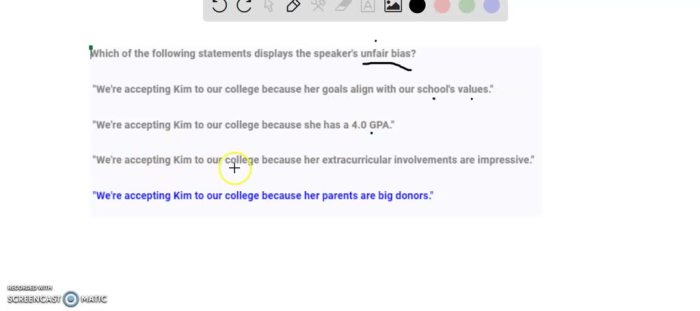Which of the following statements displays the speaker’s unfair bias – In communication, identifying unfair bias is crucial. Bias can distort messages, hindering effective understanding. This discussion delves into the concept of unfair bias, exploring techniques to recognize it in statements and its impact on communication.
Identifying Unfair Bias

Unfair bias in communication arises when individuals or groups are treated unequally or unfairly based on their personal characteristics or affiliations. These biases can manifest in various forms, including language, tone, and choice of words, and can significantly impact the way information is perceived and understood.
For example, statements that generalize about entire groups of people based on stereotypes or assumptions, such as “All politicians are corrupt” or “Women are not good at math,” demonstrate unfair bias. These statements fail to recognize individual differences and perpetuate harmful stereotypes.
Analyzing Speaker’s Intent, Which of the following statements displays the speaker’s unfair bias
When evaluating bias, it is crucial to consider the speaker’s intent. Intentional bias occurs when individuals consciously express prejudiced views or opinions, while unintentional bias arises from unconscious stereotypes or assumptions.
To identify hidden or subtle biases, it is helpful to examine the language used, the context of the statement, and the speaker’s overall tone and demeanor.
Evaluating Statement Context
The context in which a statement is made can significantly influence its interpretation. Statements that may appear biased in isolation may take on a different meaning when considered within their broader context.
For instance, a statement like “I don’t hire women for this role” could be interpreted as biased against women. However, if the speaker clarifies that the role requires physical strength and they have had negative experiences with female candidates in the past, the statement may be more nuanced and less biased.
Comparing Statements
| Statement | Bias | Criteria |
|---|---|---|
| “All immigrants are criminals.” | Unfair |
|
| “Some immigrants have committed crimes.” | Fair |
|
The criteria for evaluating bias in statements include:
- Accuracy of the statement
- Fairness in representing different perspectives
- Absence of generalizations or stereotypes
Identifying Bias in Different Media
Unfair bias can manifest in various forms of media, including:
- News articles:Selective reporting, biased language, or omission of important facts
- Advertisements:Portrayal of certain groups in stereotypical roles or targeting specific demographics based on biased assumptions
- Social media posts:Spread of misinformation, echo chambers, and reinforcement of biased beliefs
Examples of biased statements from different media sources include:
- News article:“Immigrants flood the country, taking jobs from citizens”
- Advertisement:“Women belong in the kitchen”
- Social media post:“Only white people can understand true freedom”
Impact of Unfair Bias
Unfair bias in communication can have severe negative consequences, including:
- Hindering effective communication and understanding
- Perpetuating stereotypes and discrimination
- Undermining trust and credibility
- Limiting opportunities and potential
Therefore, it is essential to be aware of unfair bias and its potential impact, and to strive for fair and unbiased communication in all forms.
User Queries: Which Of The Following Statements Displays The Speaker’s Unfair Bias
What is unfair bias?
Unfair bias refers to prejudiced or distorted views that influence communication, leading to unfair or inaccurate representations.
How can we identify hidden biases in statements?
Analyze the language used, considering loaded words, generalizations, and emotional appeals that may indicate hidden biases.
Why is context important in evaluating bias?
Context provides additional information that can clarify the speaker’s intent and help determine whether a statement is biased or not.

